 |
The Omnibus Service |
 |
| The York Tramways Company was incorporated by Act of Parliament in 1879. Their intention was to provide a small line in York using horse drawn trams. One of its most ardent supporters was William Wilkinson Wilberforce, formally of the Hermitage, SoF, now living in York and running the family chickory business. Involved in local government he became Lord Mayor in January 1880 on the unexpected death, in office, of Thomas Samuel Watkinson, Lord Mayor for 1879. He became a director of the company when his civic duties were over. In 1886 it became The City of York Tramways Company and was owned by the Bristol based Imperial and Bristol Tramway Group. At the turn of the century the services was deteriorating but it wasn't until 27th February 1909 that the York City Council were able to acquire the company. The York Corporation Act 1914 authorised the setting up of a trolley bus service in York to Heworth. This started in March 1915 and rather than trolley buses used four battery operated buses purchased from the Edison Electric Co. at the cost of £1,172 each . They were 24 seaters and one man operated with a 2d flat fare. They had charging boards at the Foss Island Rd depot, (demolished 2007) and booster charging boards also erected at the termini at Clifton and Heworth Green by the roundabout at the junction with Stockton Lane. (It is now a flower shop). By 1919 these buses were worn out and the route changed to conventional trolley buses which stayed in use until 1929. In in the same year a new bus route was introduced from the Railway Station to Stockton Lane (Hempland Lane). Trolley buses were reintroduced to the Heworth Green route on 6th October 1931 after a short spell using conventional buses. The York livery was blue and ivory. | 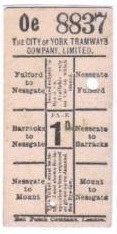 |
The West Yorkshire Road Car Company Ltd started life in 1906 as the Harrogate Road Car Company Ltd., running firstly steam buses in Harrogate, then petrol buses which were introduced in 1911. In 1924 the company was absorbed into the jointly-owned Tilling and British Automobile Traction (TBAT) group, and its name changed to the Harrogate & District Road Car Company Ltd. in 1924. As a result of the acquisition of a number of other operators and a merger with Blythe &Berwick Ltd. of 23 Charles Street, Bradford it was further renamed the West Yorkshire Road Car Company Ltd. with effect from 15/12/1927, to reflect its wider geographical spread, and from then until 1990 provided bus and coach services over a wide area of Yorkshire. It had main depots at Harrogate (also the Head Office), Bradford, Keighley, Leeds and York, together with a number of sub-depots, and for much of its existence operated over 400 buses. The company was generally referred to as West Yorkshire.
Dibbs & Warnes of 1 Station Road, Tadcaster probably ran the first service between York and Leeds. Their original service started on 10 July 1922 when they ran from the York tramway terminus in Dringhouse to the Leeds tramway terminus in Killingbeck. Their buses were not allowed to enter Leeds city until 1924. They were taken over by the Harrogate & District Road Car Company Ltd. in July 1926 just months after their first competitor started a rival service. Corcoran Bros. of Leeds Road Garage, Tadcaster were granted their first licence to run an hourly bus service between New York Road, Leeds and Rougier Street, York, via Tadcaster in May 1926. On 14/6/1929 Corcoran Bros. were refused an extension of their Leeds - York service licence to Scarborough. They started anyway on 14/7/1929, which resulted in this licence to York being withdrawn by the Watch Committee on 31/10/1929. They got over this problem by becoming a limited company, Corcoran Bros Ltd. but they also promised they would 'carefully observe' the conditions of the Watch Committee in future. Corcorans were known as the 'Ideal' Bus Service and operated with black and yellow super saloon coaches.
There were bus services running along the Malton Road prior to the mid 1920's. It is however most likely that these were express non-stopping services. The first known was the Wetherby based company of Riley & Hawkridge which split in 1925 when Hawkridge left the firm. Hawkridge kept the routes outside the Leeds area which were from Wetherby to York and York to Scarborough and Riley became H Riley & Co. of Bridge Holme, Wetherby who were taken over by the Harrogate and District Road Car Company Ltd in November 1927.
In February 1927 Bullock & Sons were granted a licence to run a long distance seasonal service from Leeds to Scarborough.
In 1928 the West Yorkshire Road Car Co. Ltd. first introduced a through bus service linking Leeds, York, Malton and Scarborough. The journey then took 3 hours 55 minutes, cost of 4/6d single (7/6d return) and buses ran approximately every 2 hours.(Assume along the A64?)
In January 1929 the West Yorkshire Road Car Co. Ltd. ran a Manchester - Leeds - Scarborough service which was subject to the Watch Committee's long distance service regulations.
In July 1929 the LNER and LMSR jointly received licences to run a service from Halifax to Scarborough via Bradford, Leeds and York. This service was discontinued at the end of the summer season in 1929.
On Monday 29/7/1929 Yorkshire Traction started a daily service from Huddersfield to Scarborough. It left Huddersfield at 8am and arrived at Scarborough around 1.30 pm. The return journey started at 4pm. A single fare cost 8/6d. It was advertised as an excursion and only noted pickups up to Barnsley. There was a halt for 15 minutes at a hotel between York and Malton where refreshments were in readiness for Traction passengers. Seats had to be booked and provision was made for luggage. The service appears to have run until 1941 when war time fuel shortages forced it to stop, at this time it was a summer holiday express.
In 1930 the West Yorkshire and the East Yorkshire jointly started a Leeds-York-Bridlington route. It is currently not known if this was an extension to the Scarborough route, in the manner of the present Coastliner service, or if it ran down the Hull Road.
It is most likely that these services and the early West Yorkshire one were express only and didn't stop anywhere to be of use to the village. The Watch Committee (Leeds or National?) had decreed that for these long distance services seats must be booked in advance, and passengers could only be picked up or set down in depots or garages and not on the street.
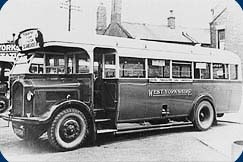
As described above at the turn of the 20th Century public transport was in its infancy and the local York bus services of little use to the Stockton villagers. Whether it was worth them using the trolley bus from Heworth Green roundabout from 1915 is debateable considering the distance they would already have had to walk, and by the time the York service had extended to Hempland Lane in 1929 things had started to improve in other ways. By the mid 1920s with buses running along the A64 the shorter walk down Sowray's Trod or Barr Lane could have made the use of one of these services possible. You mustn't forget that the village had the benefit of a rail service, with Warthill station, less than a mile from the village. According to one villager in the late 1940s/50s the village had 4 buses per day but the rail fare was cheaper at 3d return. In fact it is only since the late 1980s that Stockton has had a continuous regular bus service, meaning that before then one of these walks was necessary if long waits were to be avoided.
Going back to the pre 1700s it was common for workers to combine farming with a craft or trade. The packman or carrier was one of these trades, supplementing incomes in the slack spells before and after the hay harvest when the roads were dry and firm. As the roll of carrier was secondary the worker would be known for his main occupation and the fact he was a carrier will have been lost to history. It wasn't until 1879 that Bulmer's first recorded a carrier in Stockton, the family also had a farm and shop in the village. Around 1913 Fred Wilson became the carrier to York. He is listed as making one journey per week at 4pm every Saturday but there is no record of any other employment during the rest of the week although he was one of a number of farming Wilsons in the village throughout the years.
Some time during the 1920s Fred Wilson put his horse and cart to use to assist the village. He had a rulley or flat wagon on which he attached a wooden construction, said to either be a hen house or railway box wagon, with seats down the sides. The entrance was at the back and he had a little ladder for passengers to climb up. He would drive to York on Saturday morning and park in Fossgate, where McDonald's furniture shop is. Villagers could attend the York Market and do other business before he returned to the village at about three o'clock in the afternoon. This would then allow him time to sort himself out for his 4pm run to York as a carrier. According to Kellys/Bulmers Mr. Wilson was the Stockton carrier from at least 1913 until 1937.
|
The Electric Theatre Cinema This cinema opened in 1911 in Fossgate. At various times it was known as "the Laugh and Scratch", "the Flea Bin" and "the Flea House". It's name was changed in 1951 to the Scala and it closed in 1957. Mcdonald's Furniture Shop has been there for a long time but not known if it goes back as far as 1957. The cinema had an organ for the silent movies before talkies started. At one time they would accept a clean jam jar as admission. These were taken to a company called Clanny's where they were exchanged -1/2d for a small jam jar aand 1d for a big one. Clanny's also took in old clothing so may have been rag and bone merchants. At the time of the Tom Mix cowboy serials children paid 3d for the Saturday afternoon rush. |
After this Herbert Thompson of Holtby Lane, another farmer, improved the service as he used an old Ford wagon, again with an improvised hut like arrangement for passengers. By 1929 according to Kellys/Bulmers Mr Thompson's omnibus ran daily to York, whether it was still the wagon or a proper bus by then is unknown.
Included in the memories of Mr. Noel Bean quoted in "Looking Back at Heworth - A York Suburb" he says that he "remembers the carrier's cart that went to Stockton-on-the-Forest before there was a bus service. Mr. Thompson of Holtby Lane had the first motor service, an old Ford wagon. On a foggy night a man would walk in front of the wagon with an oil lamp".
The
first true bus service was run by G Deverew of Haxby, York.
Before 1932 he had set up two services; one from York to Flaxton and
one from York to Warthill, which went via Stockton. The buses had
wooden slatted seats and cost 1d to go into York. (It is not known if
he ran additional services or had taken over from Mr. Thompson)
The Road Traffic Act of 1930 required that bus operators should hold a Public Service Vehicle Licence, which involved mechanical inspections of their vehicles before a certificate of fitness could be granted. To comply with this new system operators also had to run at regular times and at stable fares. Thse conditions could not be attained by many of the smaller operatand many chose to sell their businesses.
On 6 May 1932 G. Deverew of York became one of the many operators taken over by the West Yorkshire Road Car Co. Ltd.; No vehicles changed hands although there is no suggestion that he had more than the two routes mentioned.
West Yorkshire first had a depot in Norton in 1933 when the local firm of William Suddaby was purchased, and a further significant move in the same year was the purchase of the Tadcaster based firm of Corcoran Brothers, which had been competing with West Yorkshire on the Leeds to Scarborough route. (Again assume along the A64 rather than through village?)
On 1 April 1934, after over a year of negotiations, West Yorkshire and York Council formed the York West Yorkshire Joint Services to run York's bus services. Initially the York fleet retained their livery while the new West Yorkshire stock was a rich red and white ornately lined out in gold and red.
In November 1934 an application was made to the Traffic Commissioners to introduce a number of new services. These were granted on 21 December 1934 and introduced on 6 January 1935. They included a transfer of the former West Yorkshire service - Piccadilly to Warthill - to the joint undertaking.
During 1936 an experimental livery of all red with three cream bands and a cream roof - the rear roof dome also being finished in red was introduced, and dropped in 1937.
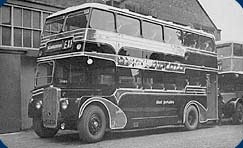
During the 1940s and 1950s there were a number of changes to the Stockton service, with the route terminating at various times at Claxton, Warthill or Barr Lane. There were as little as only 3 or 4 red buses per day.
The
road was very narrow and if a bus and car passed they had to really
squeeze into the side of the road to do so. This was not the only
obstacle to the bus driver as they often had problems at the
terminuses. At the Agar Arms in Warthill it was not unknown for the bus
to run into the pond there, while the Barr Lane junction was like a
triangle, with an attractive poplar tree in the centre of the triangle.
The bus had to back into Barr Lane to turn round and come back down the
village, but many a time they backed into the ditch and the conductor
had to get out and guide the bus by shouting and blowing a whistle.
The West Yorkshire depot was in Norton, but in 1940 land near Malton Station was bought from the London and North Eastern Railway on which to build a depot. The development of this site was delayed due to the war.
On 16 May 1942 the first bus was repainted into a wartime grey livery, although it would be towards the end of the year before any others were done. However in the mean time the whole fleet had their roofs painted grey to make them less visible from the air.
Towards the end of 1944 a start was made to repaint the buses back to a peacetime colours, although it took nearly two years to complete. An overall red was used broken by two cream bands - one at upper deck floor level and the other immediately below the upper deck windows. At first a grey roof was applied but this soon gave way to the new standard red.
In 1948 new route applications included a new service from the Railway Station to Stockton-on-the-Forest. Stockton had previously been served by the West Yorkshire service to Flaxton which was now diverted to the main road.
Also this year West Yorkshire had come under the control of the British Transport Commission, created in 1948, so effectively had been nationalised.
At this time the Leeds to Scarborough service was numbered 43 and was run by buses from four depots, Leeds, York, Malton and Scarborough in the familiar West Yorkshire livery of red and cream. It still ran as a through service every two hours, although by changing at York advantage could be taken of the Harrogate-York-Scarborough service (74), to give an hourly service. Journey time on the through service was now down to 3 hours 3 minutes and the fare was still only 5/- single (8/- return)
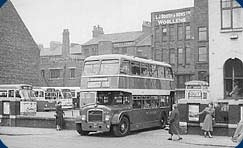
In 1949 work on the new depot in Norton was started. It cost some £20,000 and was brought into use on 3rd April 1950. The new depot opened as a sub-depot of West Yorkshire's York Depot, with an allocation of just 10 buses and was to remain so for many years. It is still the operating centre of Yorkshire Coastliner Ltd. and strangely, although the depot is adjacent to Malton Rail Station, and the postal address is Malton, it is actually in Norton.
7 December 1958 revisions include a change to the number 7 route which now ran between Leeman Road and Stockton-on-the-Forest and the old number 14 route lost its short workings to Stockton. How had Stockton been served by the number 14 for it to have been able to lose its run here?
28 May 1962 and route number 14 converted to one man operations.
29 November 1964 after an examination of existing network services to meet growing traffic demands a number of changes were made to routes including that to Stockton-on-the-Forest.
In 1965 the painting of black lining separating the cream and red phased out - cannot find when introduced but as pre joint operations West Yorks buses were lined assume it was from the start in 1934.
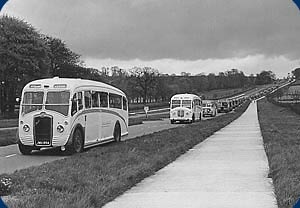
When the National Bus Company was formed in 1968 it was operating three services in York: National Bus, West Yorkshire Road Car Co (rural areas, Leeds and the East coast), and the York-West Yorkshire Joint Service until privatisation in 1987. A change to a livery of all-over poppy red, with little white relief was applied to West Yorkshire buses.
List of bus services operated on 1st Sept 1977
West Yorkshire Road Car Co. Ltd. ( assumed used A64 rather than going
through Stockton.
43 Bradford - Leeds - Woodlands Ave - York - Malton - Scarborough
43A Leeds - York - Malton
43B York - Castle Howard
X43 Bradford - Leeds -York - Scarborough - Filey (limited stop express)
82 York -Sheriff Hutton - Foston - York (circular) (assume went through SoF to A64 turned off to Flaxton, back on after
Foston - did it return through SoF)?
83 York - Claxton - Huttons Ambo - Malton (assume
went through SoF)
83B York - Claxton - Flaxton - Huttons Ambo - Malton
84 Harrogate - York - Malton -
Scarborough
York
West Yorkshire Joint Committee
14 York - Stockton - Warthill
14B York - Stockton - Claxton
Unfortunately the route map provided doesn't show all the routes.
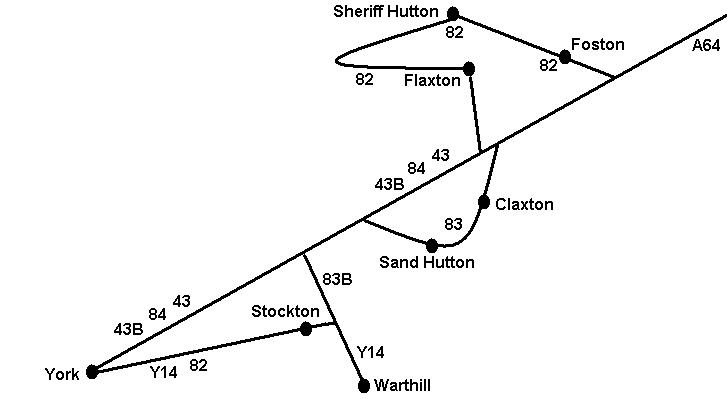
In 1980, 1981 and 1985 Transport Acts were introduced to gradually deregulate the bus companies. The joint service with York and the City Council could no longer operate and York City Council's interest was sold to West Yorkshire.
In early 1983 West Yorkshire decided to better promote its services to the East Coast and held a competition among staff to choose a suitable name. The winner won a weekend in London for two, but could not have realised how important his choice of "Yorkshire Coastliner" would prove. A special livery for vehicles used on the services was devised by West Yorkshire's Publicity Officer, breaking away from the corporate National Bus colour scheme.
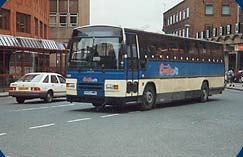
In 1985 there were only 4 buses per day, via the York to Scarborough route. The fare to York from Stockton was 70p.
Privatisation in 1987 resulted in many changes taking place to the West Yorkshire company, the principal effect of which was that the West Yorkshire name disappeared and it was broken up into smaller companies: Harrogate & District, Keighley & District and Yorkshire Coastliner. These companies continued under the control of the AJS Group until 1991 when they were acquired by the Blazefield Holdings Group (now part of Transdev UK plc)
The company was very quickly broken up into smaller companies and from August 1988 Malton and York depots came under the control of a new separate company, York City & District. Further changes resulted in the formation of a separate company, Yorkshire Coastliner Ltd., on 1st January 1990. Later that year the rest of York City & District passed to Yorkshire Rider Ltd. and is now part of First Group. Yorkshire Coastliner Ltd., with its operating centre at Malton then became a subsidiary of Blazefield Holdings Ltd. in August 1991, along with the other two remaining AJS companies in Yorkshire, Harrogate & District and Keighley & District. Yorkshire Coastliner was created as a separate limited company by North of England Travel Group to take over its Malton based operations, including the Leeds to East Coast express services, in January 1990.
Under Blazefield ownership considerable investment has been made in new buses, and the services run have grown from strength to strength. The company now runs a mixture of 20 high-quality accessible double and single decker vehicles from its Malton base, all in an attractive blue colour scheme, with route maps on the rear, and full branding for the services operated.
Coastliner is one of five companies within the Blazefield Holdings group. Blazefield Holdings has been owned by Transdev UK plc, the sixth largest bus operator in the UK, since January 2006.
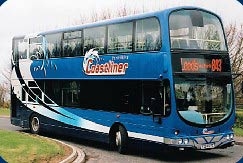
As well as the hourly service between Leeds, York, Malton, and Scarborough Yorkshire Coastliner runs regularly to Whitby, Pickering, Thornton le Dale, Filey and Bridlington. The combined frequency between Leeds, Tadcaster, York and Malton is now half hourly most of the day.
With a journey time of 2 hours 50 minutes between Leeds and Scarborough, a saving of more than an hour on those pioneering days of 1928 has been achieved.
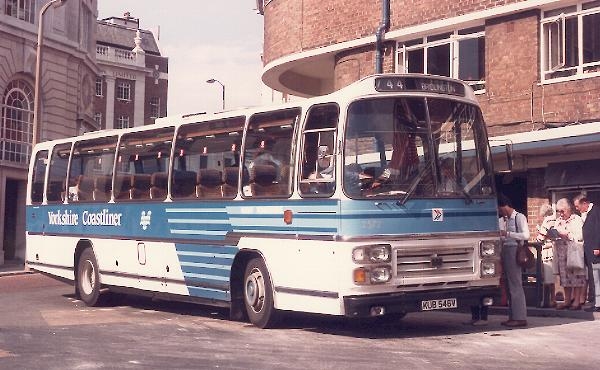
West Yorkshire 2572 (KUB546V), a Plaxton/Leopard, is seen at the former Leeds bus station in July 1984
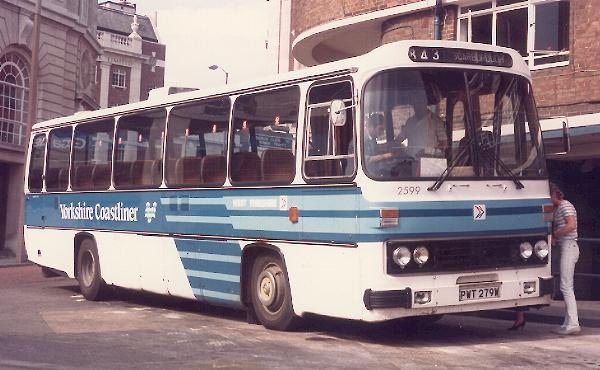
West Yorkshire 2599 (PWT279W), a Willowbrook/Leopard, on the (843) to Scarborough at the former Leeds bus station in July 1984
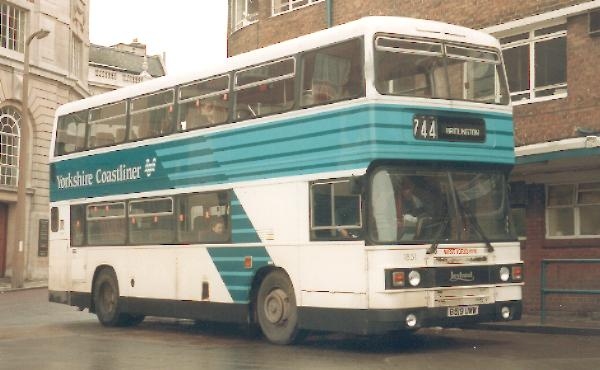
West Yorkshire ECW/Olympian 1851 (B519UWW) is seen at a wet Leeds bus station one Sunday in January 1986
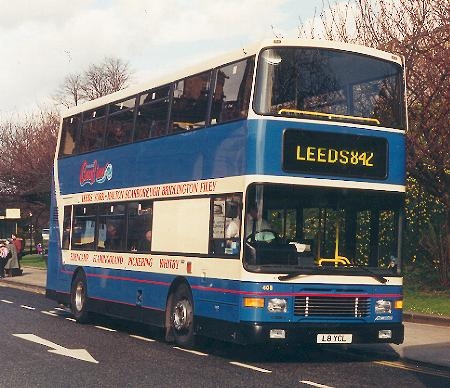
Alexander/Olympian 408 (L8YCL) is seen at York in April 1994, heading for Leeds
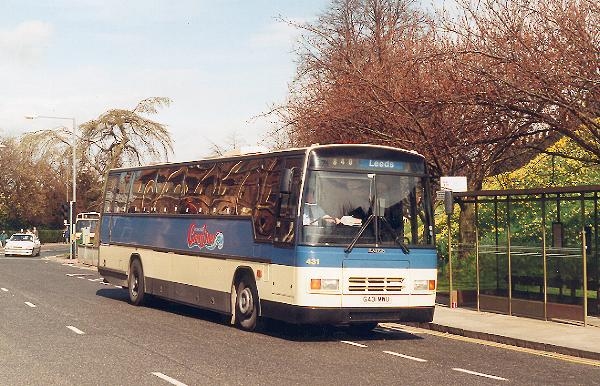
Plaxton/Tiger 431 (G431MWU) in York on the (840) to Leeds in April 1994.
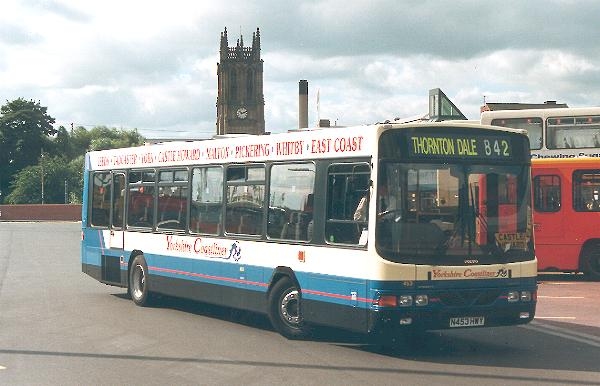
Wright/Volvo 453 (N453HWY) leaves Leeds bus station for Thornton Dale in August 1997
All above photographs from the Coastliner web site.
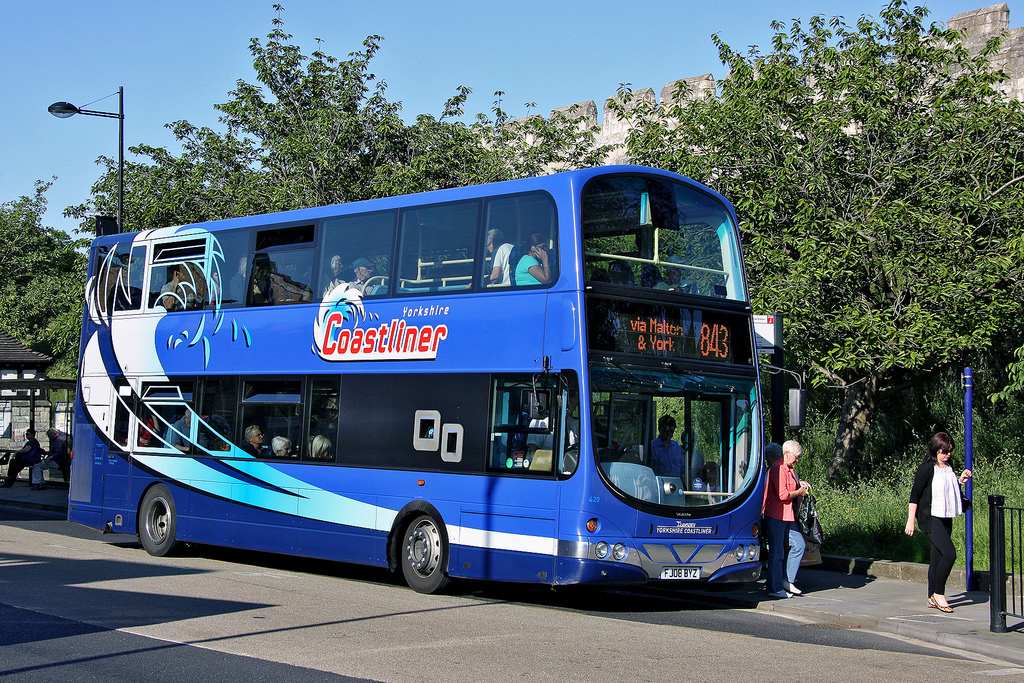 |
Yorkshire Coastliner Limited 420 FJ08 BYZ, a Volvo B9TL built 2008 with a Wright Eclipse Gemini DPH41/29F body on Station Road, York outside York railway station with the 17:37 Stockton Lane (Galtres Road) to Leeds City bus station via York and Tadcaster 843 service. Monday 1st June 2009 |
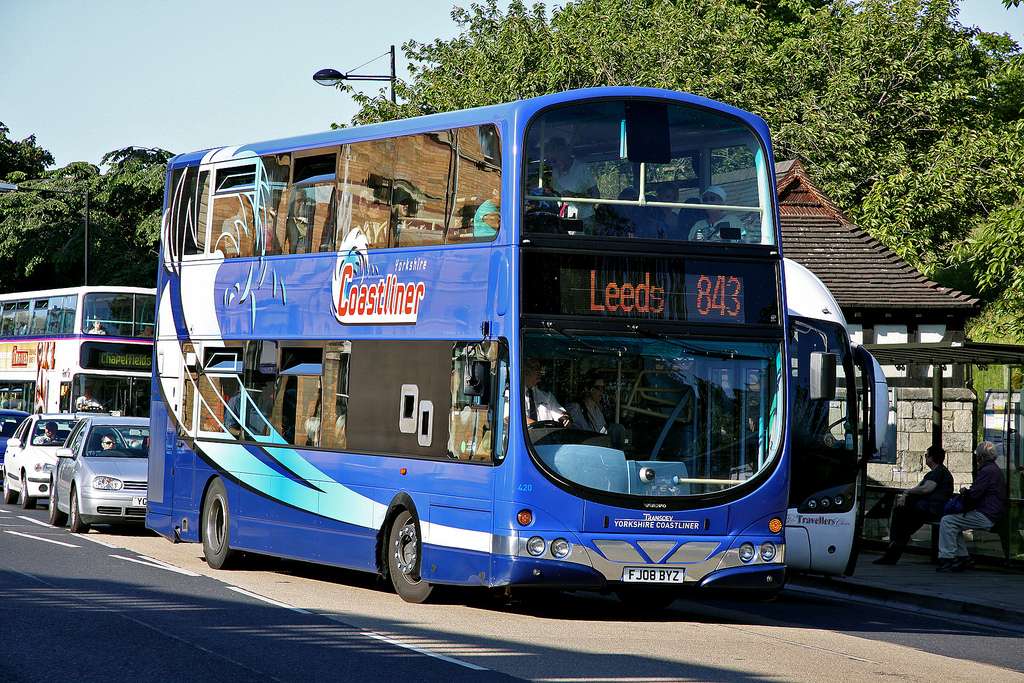 |
Yorkshire Coastliner Limited 420 FJ08 BYZ, a Volvo B9TL built 2008 with a Wright 'Eclipse Gemini' DPH41/29F body on Station Road, York outside York railway station with the 17:37 Stockton Lane (Galtres Road) to Leeds City bus station via York and Tadcaster 843 service. Monday 1st June 2009 (unknown) |
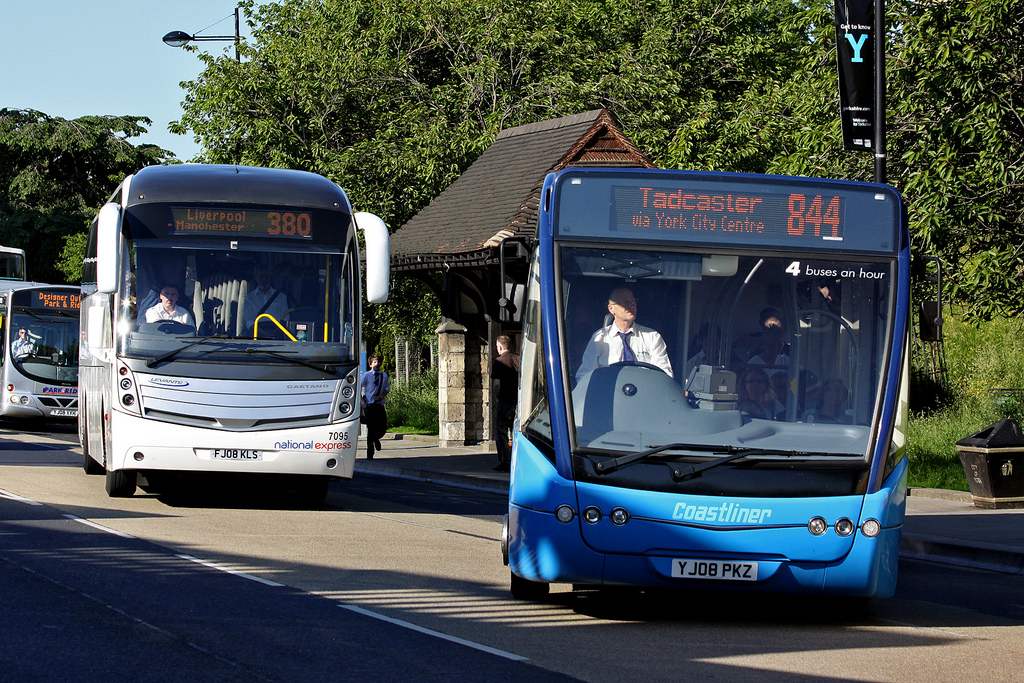 |
Yorkshire Coastliner Limited (originally Lancashire United Limited) 276 YJ08 PKZ, an Optare 'Versa' V1100 built 2008 with an Optare B37F body on Station Road, York outside York railway station with the 17:30 Heworth (Ashley Park Road) to Tadcaster (Garnet Lane) via York 844 service. (unknown) |
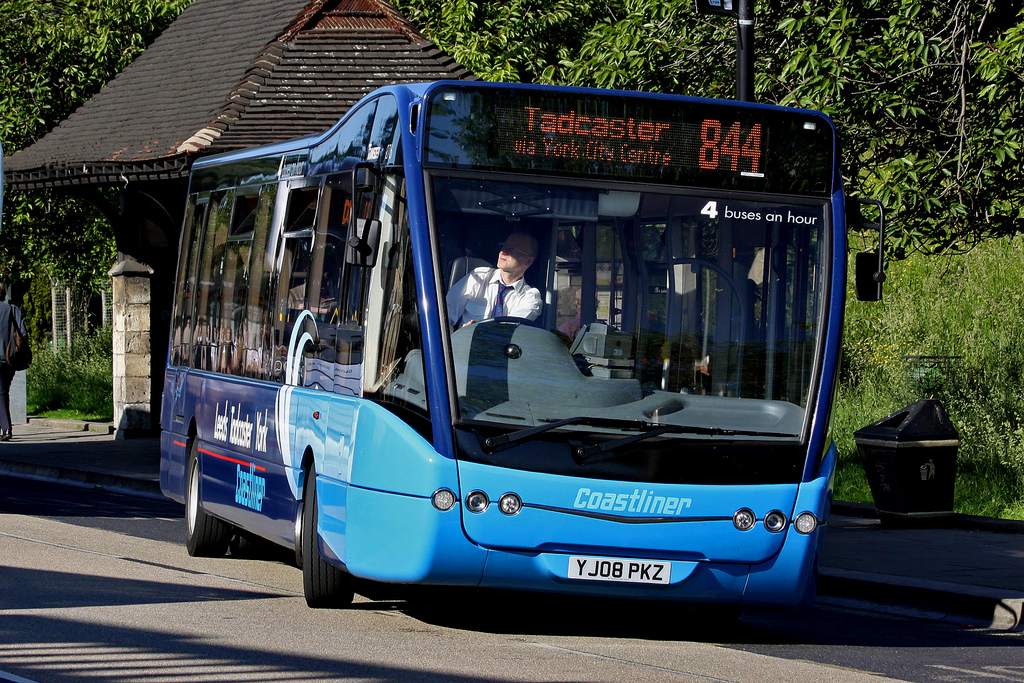 |
Yorkshire Coastliner Limited (originally Lancashire United Limited) 276 YJ08 PKZ, an Optare 'Versa' V1100 built 2008 with an Optare B37F body on Station Road, York outside York railway station with the 17:30 Heworth (Ashley Park Road) to Tadcaster (Garnet Lane) via York 844 service. Monday 1st June 2009. (unknown) |
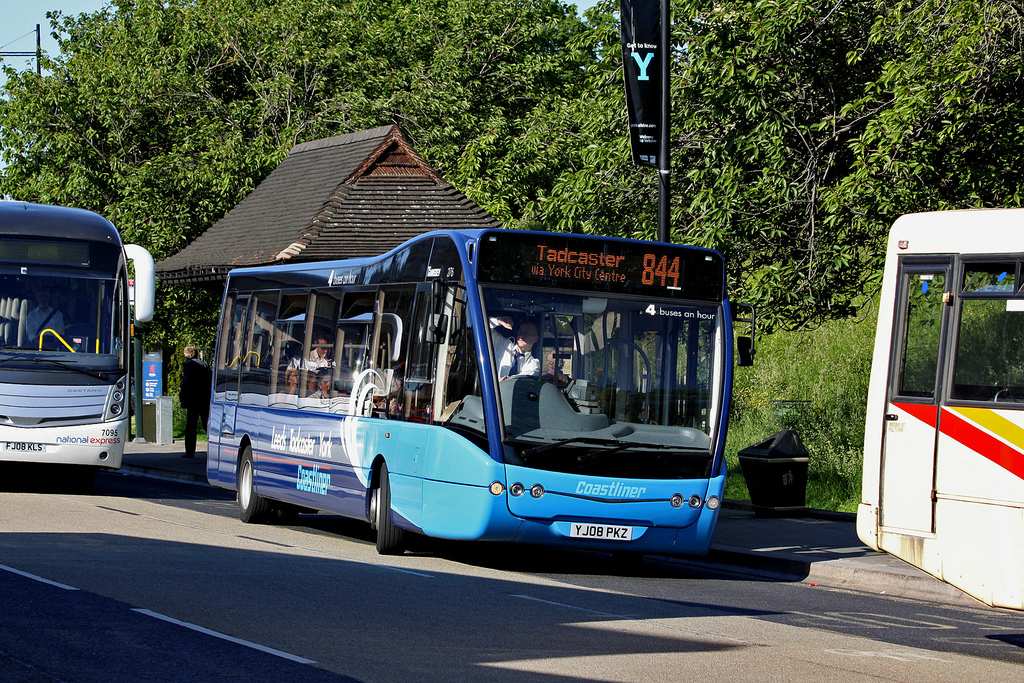 |
Yorkshire Coastliner Limited (originally Lancashire United Limited) 276 YJ08 PKZ, an Optare 'Versa' V1100 built 2008 with an Optare B37F body on Station Road, York outside York railway station with the 17:30 Heworth (Ashley Park Road) to Tadcaster (Garnet Lane) via York 844 service. Monday 1st June 2009. (unknown) |
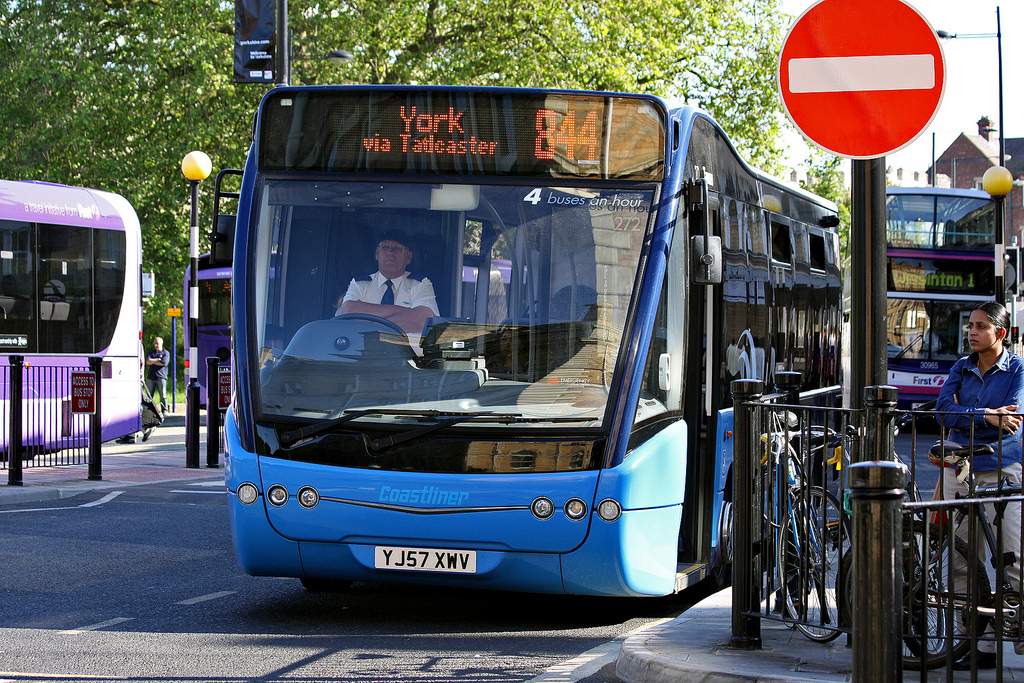 |
Yorkshire Coastliner Limited (originally Lancashire United Limited) 272 YJ57 XWV, an Optare 'Versa' V1100 built 2008 with an Optare B37F body on Station Road, York outside York railway station with the 16:30 Leeds City bus station to Heworth (Ashley Park Road) via Tadcaster and York 844 service. Monday 1st June 2009. (unknown) |
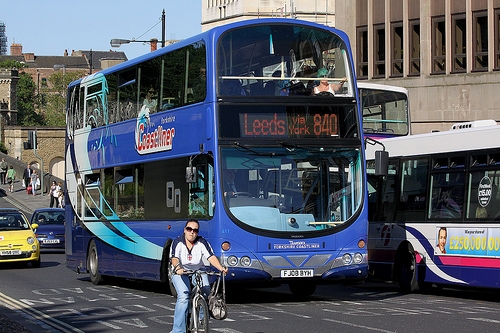 |
Yorkshire Coastliner Limited 411 FJ08 BYH, a Volvo B9TL built 2008 with a Wright 'Eclipse Gemini' DPH41/29F body on Station Road, York with the 16:40 Stockton Lane (Galtres Road) to Leeds City bus station via York and Tadcaster 840 service. Monday 1st June 2009. (unknown) |
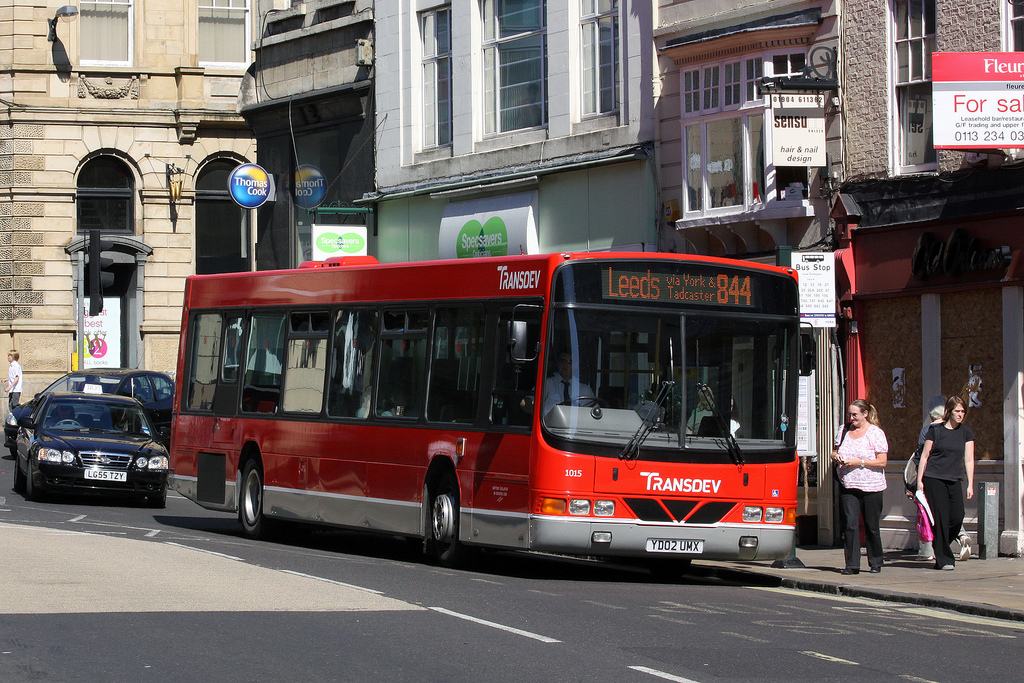 |
Yorkshire Coastliner Limited 1015 YD02 UMX, a Volvo B10BLE built 2002 with a Wright 'Renown' DP44F body on Low Ousegate, York with the 15:52 Heworth (Ashley Park Road) to Leeds (Park Row) via York and Tadcaster 844 service. Monday 1st June 2009. (unknown) |
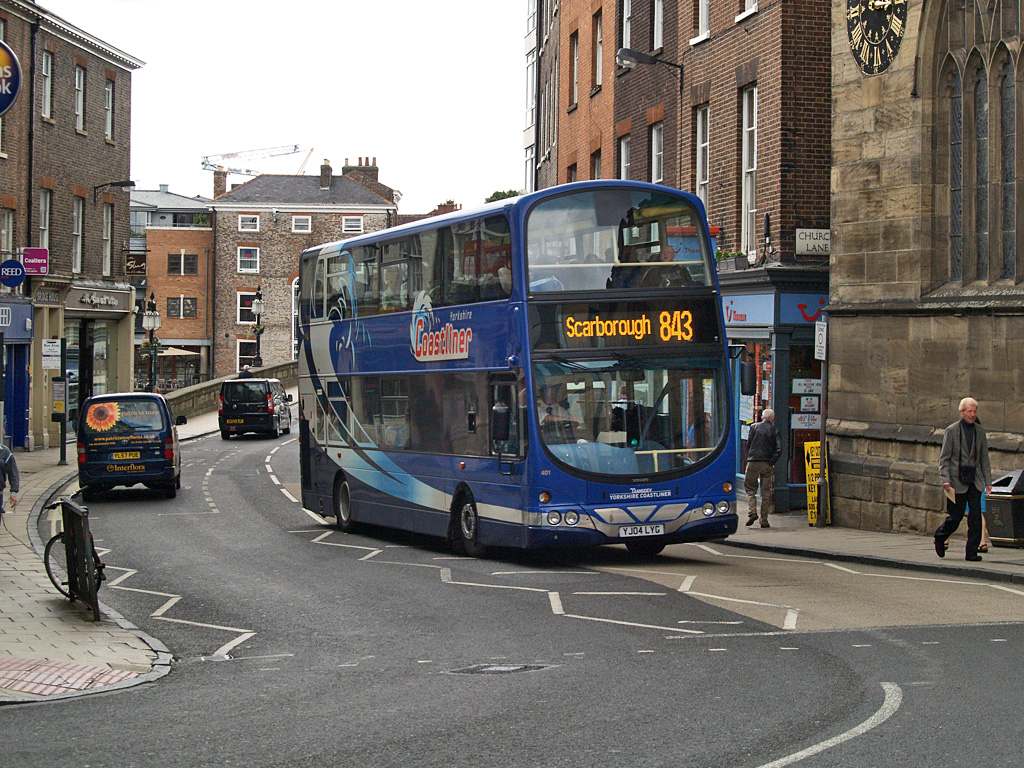 |
Yorkshire Coastliner Limited 401 YJ04 LYG, a Volvo B7TL built 2004 with a Wright 'Eclipse Gemini' CH41/28F body on Low Ousegate in York with the 13:45 Leeds City Bus Station to Scarborough (Peasholm Park) via Tadcaster, York and Malton 843 service. Thursday 12th June 2008. (unknown) |
The Ryedale Link
Small minibus operated late 1980s? following privatisation of the national buses in 1987? when Leeds - Scarborough service by passed the village. Operated a loose timetable and would collect from your door.
Bibliography
York City Buses by Keith
A Jenkinson. Autobus Review Publications LTD, Bradford 1984 ISBN
090783406X
West Yorkshire a National Bus company.
Looking Back at Heworth - A York Suburb by Avril E Webster Appleton
(local history type booklet).
Leeds Transport by J. Soper, Dipl. Arch, Dipl. T.P. Amadeus Press Ltd.
1996.